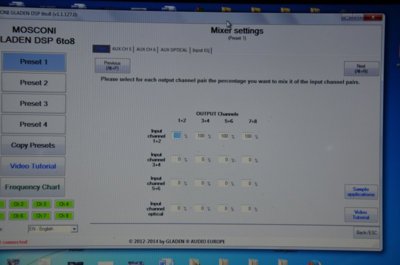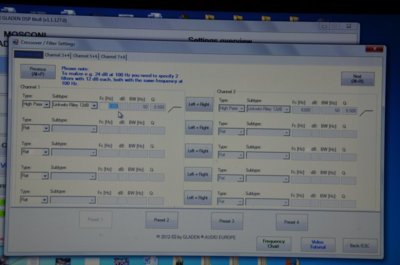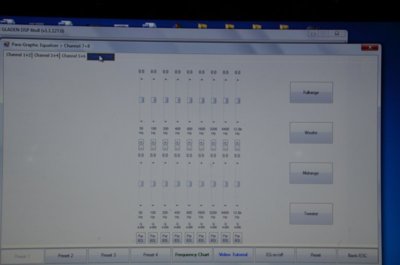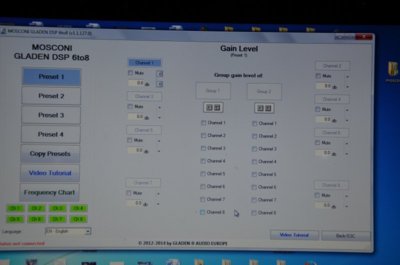for a drop in fit, the speaker sizes are a 5x7 or 6x8. either one of those sizes will fit. however the more common size is a 5x7. the front tweeters are 1 inch in diameter. the center speaker is a 4 inch. i disregard the center speaker when upgrading the audio system.
you have a component setup in front meaning that the front door woofer and the front tweeter act as 1 complete speaker on each side. for the more advanced systems, a 6 1/2 inch speaker can be used. in this case the front door woofer (6 1/2") can be spaced out 3/4" to accommodate a higher end speaker that has a larger magnet, and will still clear the door panel. keep in mind you may need to do a little additional modification. the tweeter should pose no problem replacing and is for the most parts, self explanatory when the panel and tweeter are removed.
the rears are a coax setup meaning that it plays a full range signal with a cap inline on the tweeter to filter out the bass going to it. it can be swapped for another coax with no other mods necessary. if you wish to run a 6 1/2" speaker instead, it can be spaced out 1/2" from the door. wires can easily be ran in the rear door boots of both the crew and supercabs for those of you that want to run a component setup in the rear.
for a subwoofer, the oem is an 8" but can easily hold a larger speaker. for the supercabs, certain 12" shallow mount subwoofers will fit under the seat without sticking out, and some will not. due to height issues, supercab owners are limited to shallow mount woofers. however, certain manufacturers have built some pretty darn good shallow subs. for the crewcabs, only a 10" or smaller speaker will fit under the rear seat without sticking out. but due to the extra height, some full size woofers will fit. and you are not "stuck" with having to go with a shallow mount woofer like the supercab owners.
against popular belief, the oem speaker wire is plenty adequate to run your system. here are my thoughts
auto manufacturers can skimp on certain parts of a vehicle but wires are not one of them. copper is the second most conductive metal on the planet next to silver. however we all know the cost of silver is exponentially greater than copper. so copper is the best choice by default. the reason for copper wire is that since its conductivity is so great, there is less resistance in the transfer of current. resistance means heat. and heat equals nothing good. if an auto manufacturer decided to skimp on wire, then there would be a lot more heat generated in the wires that conduct higher current. this could allow for more wiring issues, melted wires, and worse case scenario, a vehicle fire. there are some auto companies that are starting to use an aluminum clad copper wire for some of the low current electronics that power nothing but relays, but when it counts, i guarantee theres copper involved.
so based on my testing, i have found that the copper wire used for our existing audio system can handle quite a bit of current. about 25amps before the wire insulation started to melt. (duration was not tested, just to the melting point) do the math, and thats 350 watts. 150watts more than what my speakers are seeing right now. so the oem wire is fine. besides the fact you cant really run wires in the front doors without major modification, there is no need to upgrade the wire. but your choice in wire for an amp wiring kit should be made knowing the facts about wire. real power kits that use real wire are going to cost a lot more than the cheap power kits. the cheap power kits are the aluminum clad copper, where as the high end power kits are pure copper. there is a happy medium where there is an aluminum clad copper (also known as copper clad aluminum), but the aluminum content is much lower than the super cheap kits you will find. so when deciding on a power kit for your amplifiers, make sure you stick with a name brand. some for example are kicker, stinger, rockford, jl audio, wirez, etc.
you have a component setup in front meaning that the front door woofer and the front tweeter act as 1 complete speaker on each side. for the more advanced systems, a 6 1/2 inch speaker can be used. in this case the front door woofer (6 1/2") can be spaced out 3/4" to accommodate a higher end speaker that has a larger magnet, and will still clear the door panel. keep in mind you may need to do a little additional modification. the tweeter should pose no problem replacing and is for the most parts, self explanatory when the panel and tweeter are removed.
the rears are a coax setup meaning that it plays a full range signal with a cap inline on the tweeter to filter out the bass going to it. it can be swapped for another coax with no other mods necessary. if you wish to run a 6 1/2" speaker instead, it can be spaced out 1/2" from the door. wires can easily be ran in the rear door boots of both the crew and supercabs for those of you that want to run a component setup in the rear.
for a subwoofer, the oem is an 8" but can easily hold a larger speaker. for the supercabs, certain 12" shallow mount subwoofers will fit under the seat without sticking out, and some will not. due to height issues, supercab owners are limited to shallow mount woofers. however, certain manufacturers have built some pretty darn good shallow subs. for the crewcabs, only a 10" or smaller speaker will fit under the rear seat without sticking out. but due to the extra height, some full size woofers will fit. and you are not "stuck" with having to go with a shallow mount woofer like the supercab owners.
against popular belief, the oem speaker wire is plenty adequate to run your system. here are my thoughts
auto manufacturers can skimp on certain parts of a vehicle but wires are not one of them. copper is the second most conductive metal on the planet next to silver. however we all know the cost of silver is exponentially greater than copper. so copper is the best choice by default. the reason for copper wire is that since its conductivity is so great, there is less resistance in the transfer of current. resistance means heat. and heat equals nothing good. if an auto manufacturer decided to skimp on wire, then there would be a lot more heat generated in the wires that conduct higher current. this could allow for more wiring issues, melted wires, and worse case scenario, a vehicle fire. there are some auto companies that are starting to use an aluminum clad copper wire for some of the low current electronics that power nothing but relays, but when it counts, i guarantee theres copper involved.
so based on my testing, i have found that the copper wire used for our existing audio system can handle quite a bit of current. about 25amps before the wire insulation started to melt. (duration was not tested, just to the melting point) do the math, and thats 350 watts. 150watts more than what my speakers are seeing right now. so the oem wire is fine. besides the fact you cant really run wires in the front doors without major modification, there is no need to upgrade the wire. but your choice in wire for an amp wiring kit should be made knowing the facts about wire. real power kits that use real wire are going to cost a lot more than the cheap power kits. the cheap power kits are the aluminum clad copper, where as the high end power kits are pure copper. there is a happy medium where there is an aluminum clad copper (also known as copper clad aluminum), but the aluminum content is much lower than the super cheap kits you will find. so when deciding on a power kit for your amplifiers, make sure you stick with a name brand. some for example are kicker, stinger, rockford, jl audio, wirez, etc.
Last edited:










